2016 NISSAN MURANO HYBRID engine overheat
[x] Cancel search: engine overheatPage 9 of 443
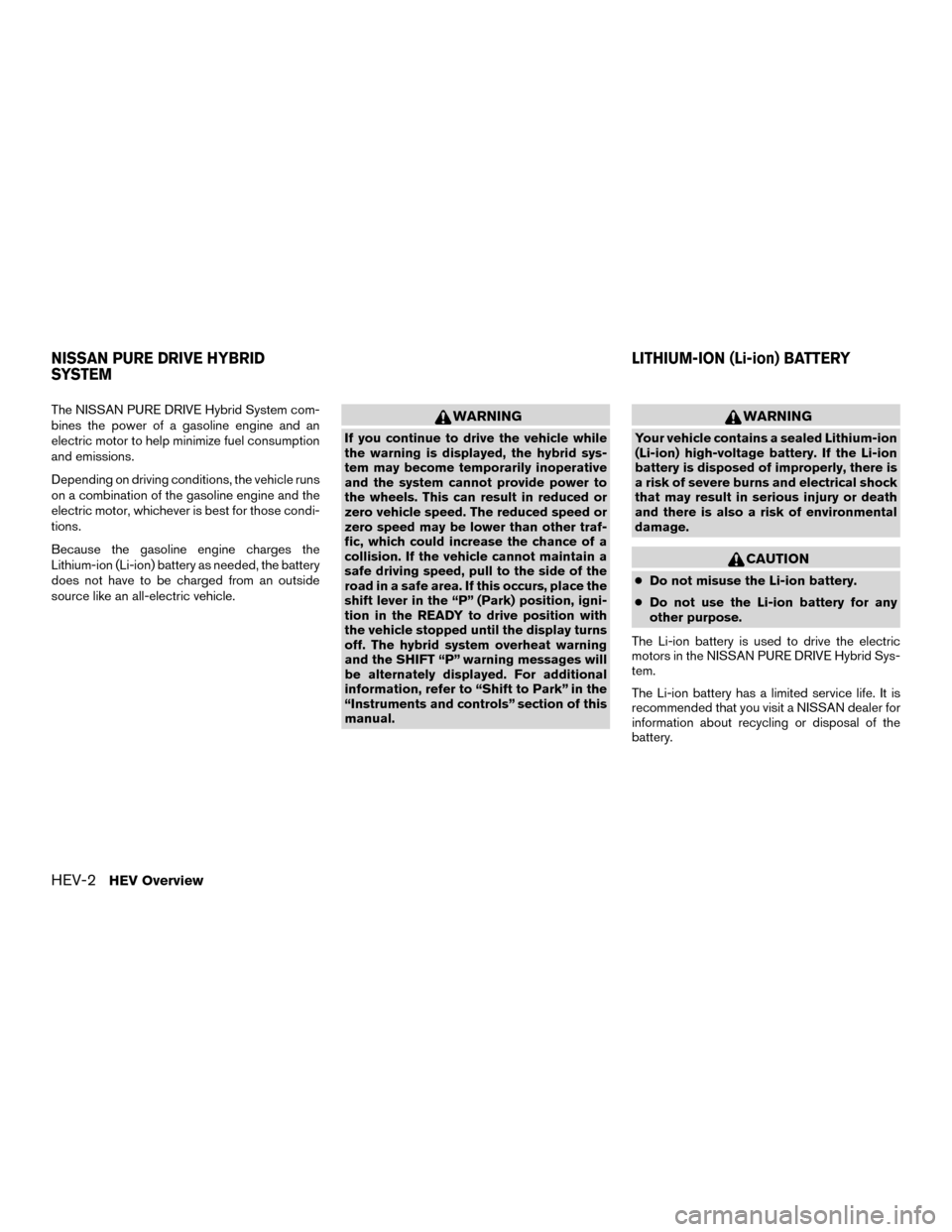
The NISSAN PURE DRIVE Hybrid System com-
bines the power of a gasoline engine and an
electric motor to help minimize fuel consumption
and emissions.
Depending on driving conditions, the vehicle runs
on a combination of the gasoline engine and the
electric motor, whichever is best for those condi-
tions.
Because the gasoline engine charges the
Lithium-ion (Li-ion) battery as needed, the battery
does not have to be charged from an outside
source like an all-electric vehicle.WARNING
If you continue to drive the vehicle while
the warning is displayed, the hybrid sys-
tem may become temporarily inoperative
and the system cannot provide power to
the wheels. This can result in reduced or
zero vehicle speed. The reduced speed or
zero speed may be lower than other traf-
fic, which could increase the chance of a
collision. If the vehicle cannot maintain a
safe driving speed, pull to the side of the
road in a safe area. If this occurs, place the
shift lever in the “P” (Park) position, igni-
tion in the READY to drive position with
the vehicle stopped until the display turns
off. The hybrid system overheat warning
and the SHIFT “P” warning messages will
be alternately displayed. For additional
information, refer to “Shift to Park” in the
“Instruments and controls” section of this
manual.
WARNING
Your vehicle contains a sealed Lithium-ion
(Li-ion) high-voltage battery. If the Li-ion
battery is disposed of improperly, there is
a risk of severe burns and electrical shock
that may result in serious injury or death
and there is also a risk of environmental
damage.
CAUTION
●Do not misuse the Li-ion battery.
● Do not use the Li-ion battery for any
other purpose.
The Li-ion battery is used to drive the electric
motors in the NISSAN PURE DRIVE Hybrid Sys-
tem.
The Li-ion battery has a limited service life. It is
recommended that you visit a NISSAN dealer for
information about recycling or disposal of the
battery.
NISSAN PURE DRIVE HYBRID
SYSTEM LITHIUM-ION (Li-ion) BATTERY
HEV-2HEV Overview
Page 121 of 443
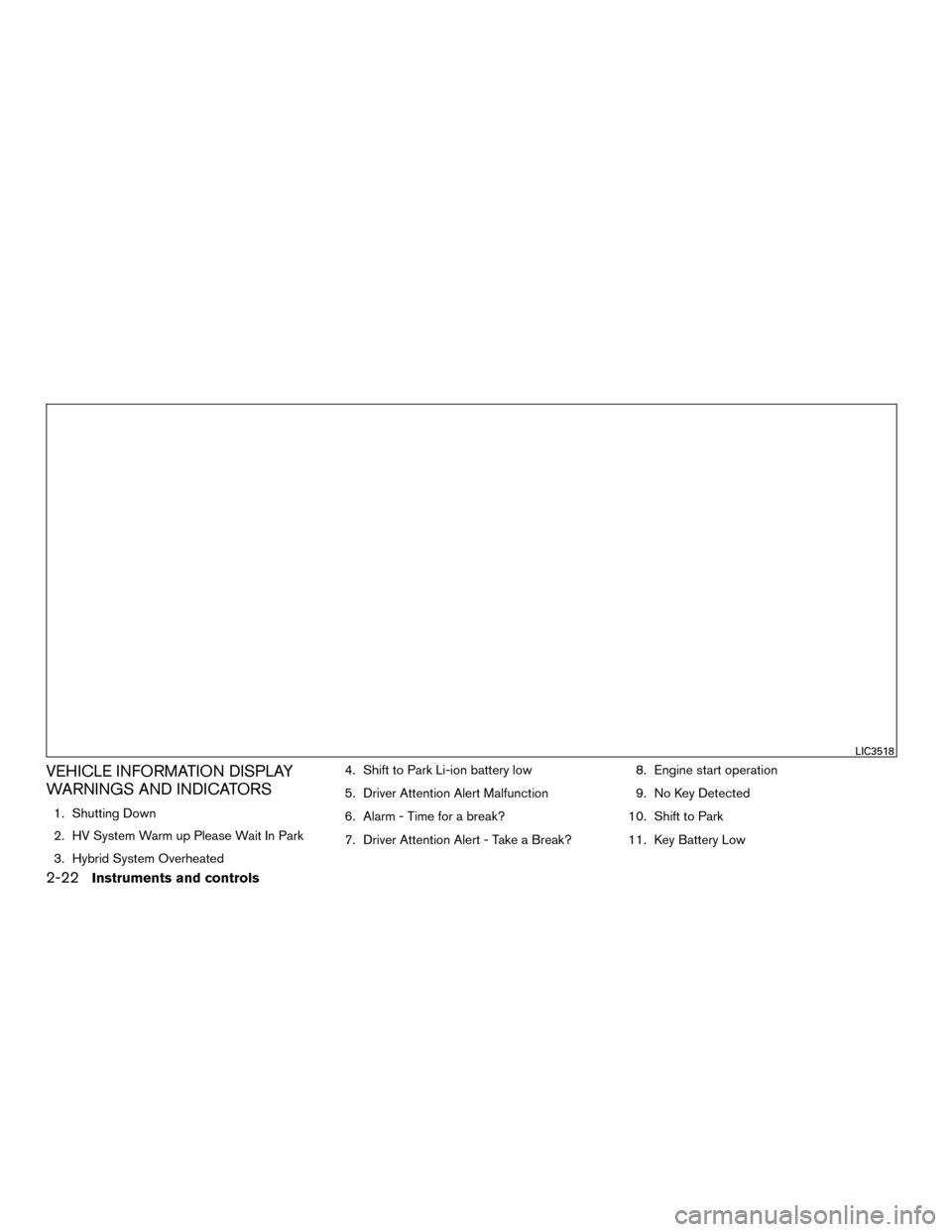
VEHICLE INFORMATION DISPLAY
WARNINGS AND INDICATORS
1. Shutting Down
2. HV System Warm up Please Wait In Park
3. Hybrid System Overheated4. Shift to Park Li-ion battery low
5. Driver Attention Alert Malfunction
6. Alarm - Time for a break?
7. Driver Attention Alert - Take a Break?
8. Engine start operation
9. No Key Detected
10. Shift to Park
11. Key Battery Low
LIC3518
2-22Instruments and controls
Page 122 of 443
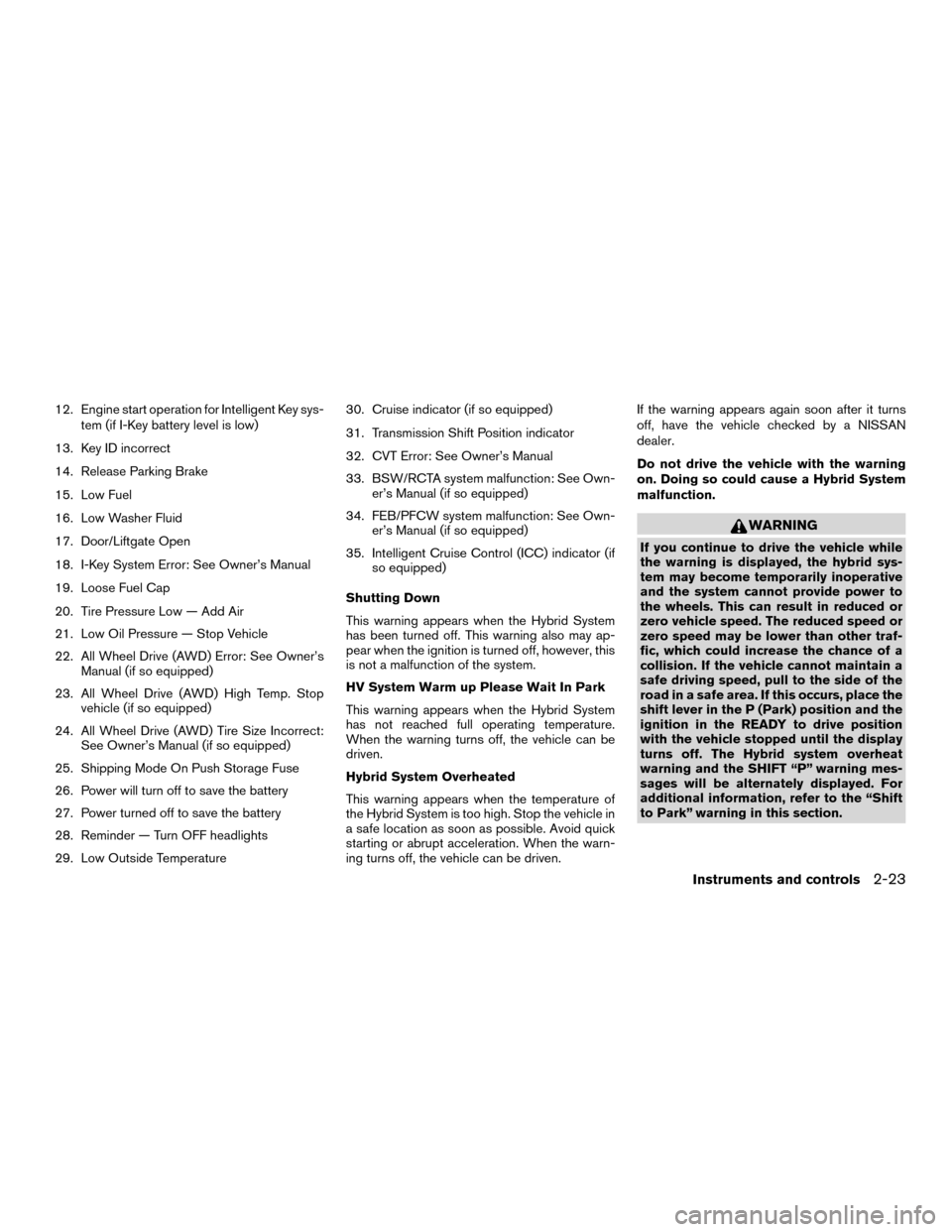
12. Engine start operation for Intelligent Key sys-tem (if I-Key battery level is low)
13. Key ID incorrect
14. Release Parking Brake
15. Low Fuel
16. Low Washer Fluid
17. Door/Liftgate Open
18. I-Key System Error: See Owner’s Manual
19. Loose Fuel Cap
20. Tire Pressure Low — Add Air
21. Low Oil Pressure — Stop Vehicle
22. All Wheel Drive (AWD) Error: See Owner’s Manual (if so equipped)
23. All Wheel Drive (AWD) High Temp. Stop vehicle (if so equipped)
24. All Wheel Drive (AWD) Tire Size Incorrect: See Owner’s Manual (if so equipped)
25. Shipping Mode On Push Storage Fuse
26. Power will turn off to save the battery
27. Power turned off to save the battery
28. Reminder — Turn OFF headlights
29. Low Outside Temperature 30. Cruise indicator (if so equipped)
31. Transmission Shift Position indicator
32. CVT Error: See Owner’s Manual
33. BSW/RCTA system malfunction: See Own-
er’s Manual (if so equipped)
34. FEB/PFCW system malfunction: See Own- er’s Manual (if so equipped)
35. Intelligent Cruise Control (ICC) indicator (if so equipped)
Shutting Down
This warning appears when the Hybrid System
has been turned off. This warning also may ap-
pear when the ignition is turned off, however, this
is not a malfunction of the system.
HV System Warm up Please Wait In Park
This warning appears when the Hybrid System
has not reached full operating temperature.
When the warning turns off, the vehicle can be
driven.
Hybrid System Overheated
This warning appears when the temperature of
the Hybrid System is too high. Stop the vehicle in
a safe location as soon as possible. Avoid quick
starting or abrupt acceleration. When the warn-
ing turns off, the vehicle can be driven. If the warning appears again soon after it turns
off, have the vehicle checked by a NISSAN
dealer.
Do not drive the vehicle with the warning
on. Doing so could cause a Hybrid System
malfunction.
WARNING
If you continue to drive the vehicle while
the warning is displayed, the hybrid sys-
tem may become temporarily inoperative
and the system cannot provide power to
the wheels. This can result in reduced or
zero vehicle speed. The reduced speed or
zero speed may be lower than other traf-
fic, which could increase the chance of a
collision. If the vehicle cannot maintain a
safe driving speed, pull to the side of the
road in a safe area. If this occurs, place the
shift lever in the P (Park) position and the
ignition in the READY to drive position
with the vehicle stopped until the display
turns off. The Hybrid system overheat
warning and the SHIFT “P” warning mes-
sages will be alternately displayed. For
additional information, refer to the “Shift
to Park” warning in this section.
Instruments and controls2-23
Page 141 of 443
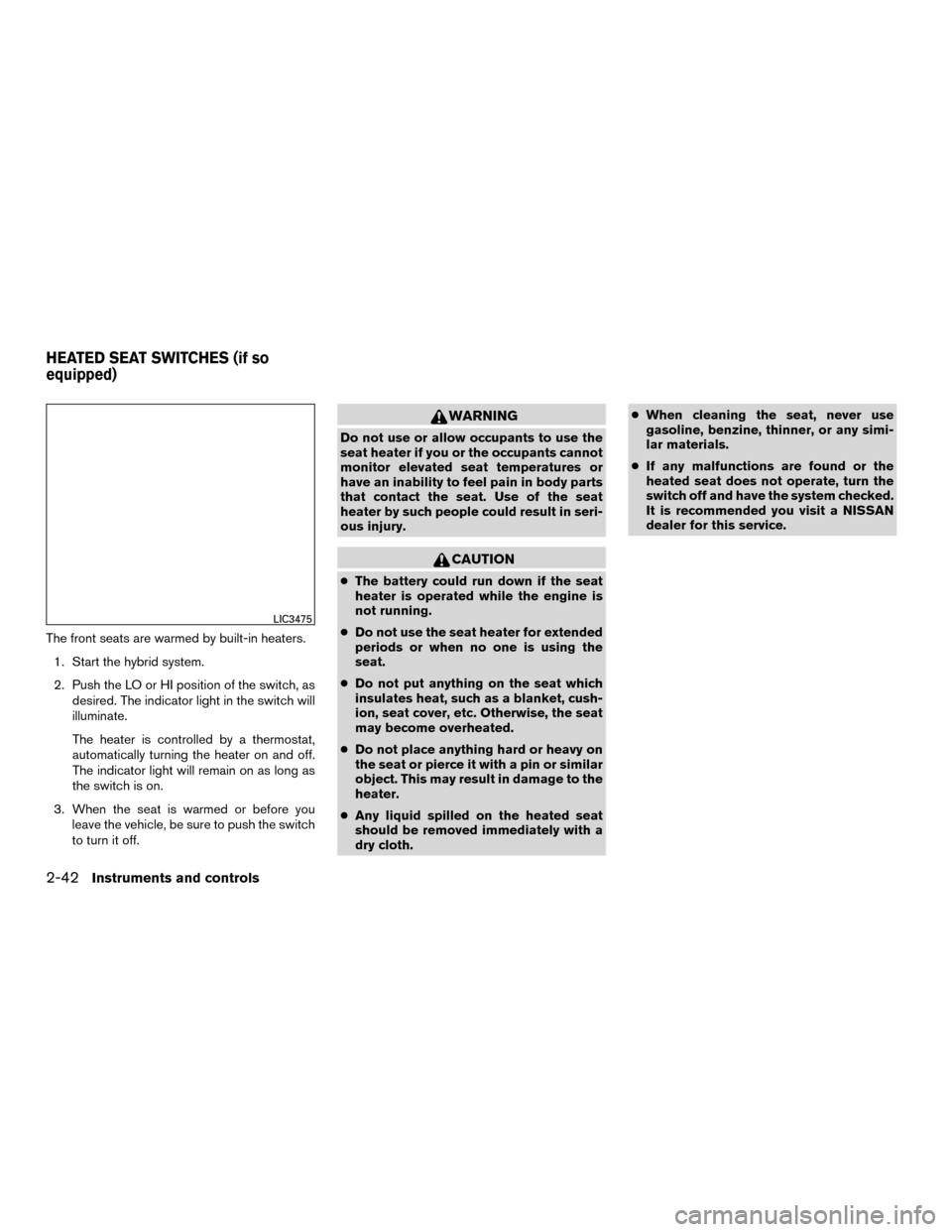
The front seats are warmed by built-in heaters.1. Start the hybrid system.
2. Push the LO or HI position of the switch, as desired. The indicator light in the switch will
illuminate.
The heater is controlled by a thermostat,
automatically turning the heater on and off.
The indicator light will remain on as long as
the switch is on.
3. When the seat is warmed or before you leave the vehicle, be sure to push the switch
to turn it off.
WARNING
Do not use or allow occupants to use the
seat heater if you or the occupants cannot
monitor elevated seat temperatures or
have an inability to feel pain in body parts
that contact the seat. Use of the seat
heater by such people could result in seri-
ous injury.
CAUTION
●The battery could run down if the seat
heater is operated while the engine is
not running.
● Do not use the seat heater for extended
periods or when no one is using the
seat.
● Do not put anything on the seat which
insulates heat, such as a blanket, cush-
ion, seat cover, etc. Otherwise, the seat
may become overheated.
● Do not place anything hard or heavy on
the seat or pierce it with a pin or similar
object. This may result in damage to the
heater.
● Any liquid spilled on the heated seat
should be removed immediately with a
dry cloth. ●
When cleaning the seat, never use
gasoline, benzine, thinner, or any simi-
lar materials.
● If any malfunctions are found or the
heated seat does not operate, turn the
switch off and have the system checked.
It is recommended you visit a NISSAN
dealer for this service.
LIC3475
HEATED SEAT SWITCHES (if so
equipped)
2-42Instruments and controls
Page 142 of 443
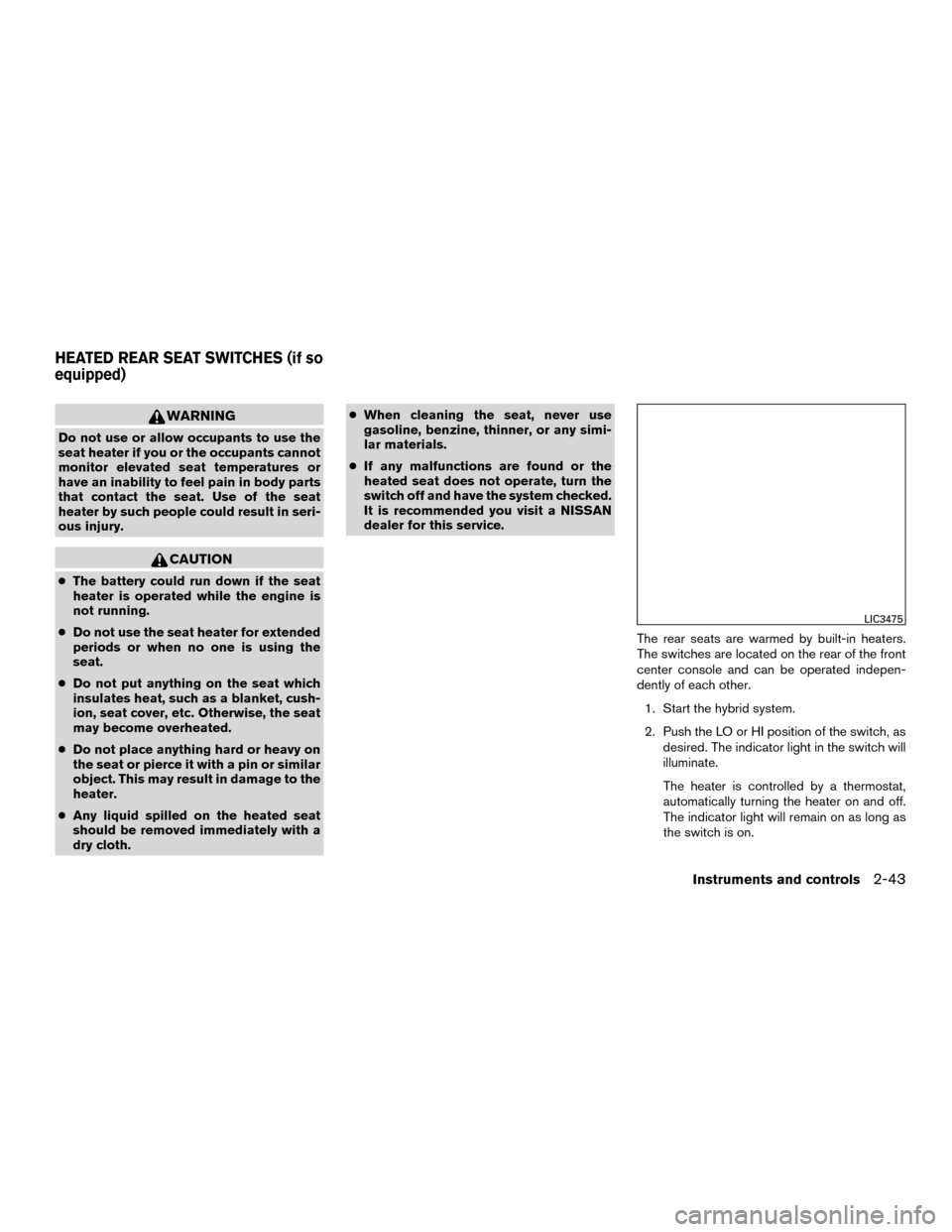
WARNING
Do not use or allow occupants to use the
seat heater if you or the occupants cannot
monitor elevated seat temperatures or
have an inability to feel pain in body parts
that contact the seat. Use of the seat
heater by such people could result in seri-
ous injury.
CAUTION
●The battery could run down if the seat
heater is operated while the engine is
not running.
● Do not use the seat heater for extended
periods or when no one is using the
seat.
● Do not put anything on the seat which
insulates heat, such as a blanket, cush-
ion, seat cover, etc. Otherwise, the seat
may become overheated.
● Do not place anything hard or heavy on
the seat or pierce it with a pin or similar
object. This may result in damage to the
heater.
● Any liquid spilled on the heated seat
should be removed immediately with a
dry cloth. ●
When cleaning the seat, never use
gasoline, benzine, thinner, or any simi-
lar materials.
● If any malfunctions are found or the
heated seat does not operate, turn the
switch off and have the system checked.
It is recommended you visit a NISSAN
dealer for this service.
The rear seats are warmed by built-in heaters.
The switches are located on the rear of the front
center console and can be operated indepen-
dently of each other.1. Start the hybrid system.
2. Push the LO or HI position of the switch, as desired. The indicator light in the switch will
illuminate.
The heater is controlled by a thermostat,
automatically turning the heater on and off.
The indicator light will remain on as long as
the switch is on.
LIC3475
HEATED REAR SEAT SWITCHES (if so
equipped)
Instruments and controls2-43
Page 144 of 443
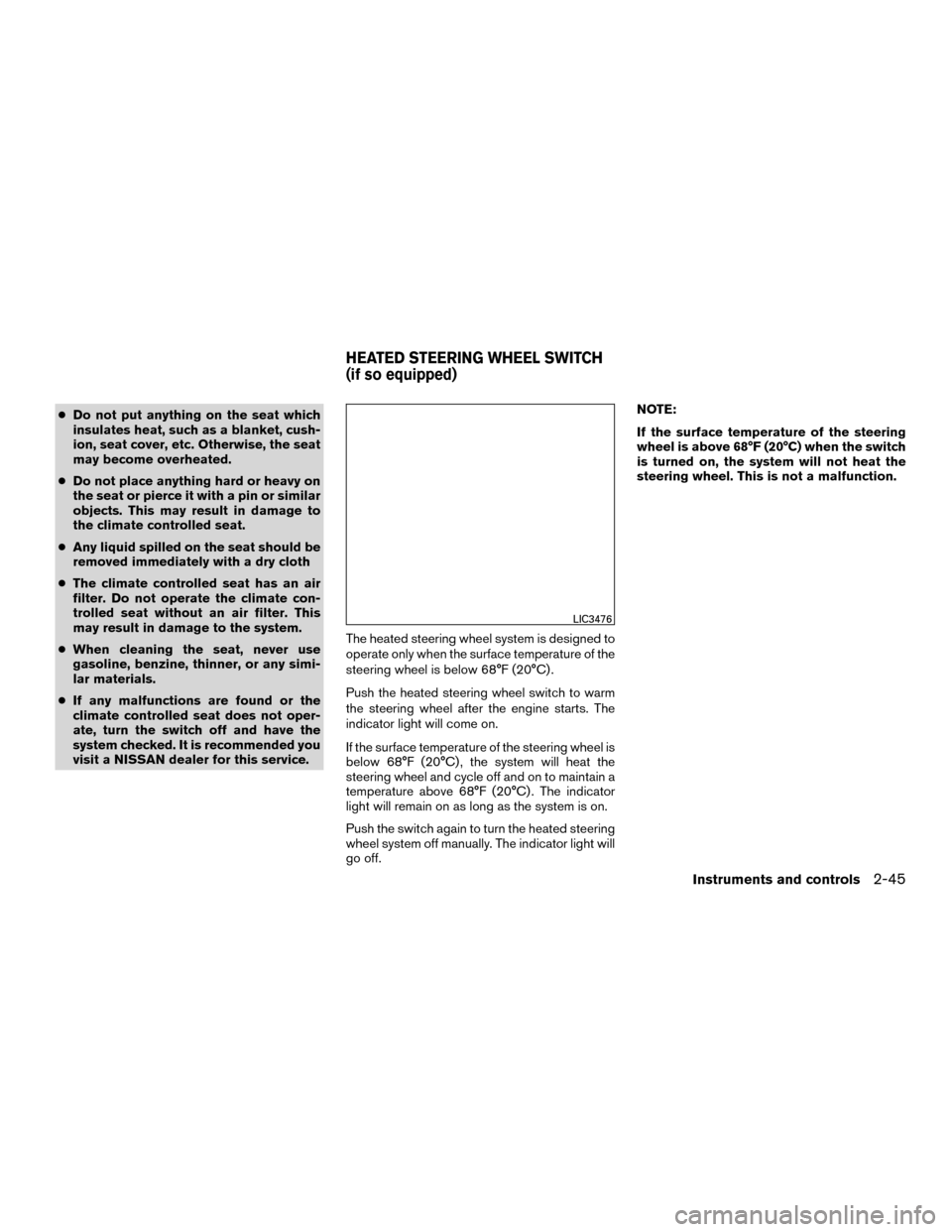
●Do not put anything on the seat which
insulates heat, such as a blanket, cush-
ion, seat cover, etc. Otherwise, the seat
may become overheated.
● Do not place anything hard or heavy on
the seat or pierce it with a pin or similar
objects. This may result in damage to
the climate controlled seat.
● Any liquid spilled on the seat should be
removed immediately with a dry cloth
● The climate controlled seat has an air
filter. Do not operate the climate con-
trolled seat without an air filter. This
may result in damage to the system.
● When cleaning the seat, never use
gasoline, benzine, thinner, or any simi-
lar materials.
● If any malfunctions are found or the
climate controlled seat does not oper-
ate, turn the switch off and have the
system checked. It is recommended you
visit a NISSAN dealer for this service. The heated steering wheel system is designed to
operate only when the surface temperature of the
steering wheel is below 68°F (20°C) .
Push the heated steering wheel switch to warm
the steering wheel after the engine starts. The
indicator light will come on.
If the surface temperature of the steering wheel is
below 68°F (20°C) , the system will heat the
steering wheel and cycle off and on to maintain a
temperature above 68°F (20°C) . The indicator
light will remain on as long as the system is on.
Push the switch again to turn the heated steering
wheel system off manually. The indicator light will
go off. NOTE:
If the surface temperature of the steering
wheel is above 68°F (20°C) when the switch
is turned on, the system will not heat the
steering wheel. This is not a malfunction.
LIC3476
HEATED STEERING WHEEL SWITCH
(if so equipped)
Instruments and controls2-45
Page 146 of 443
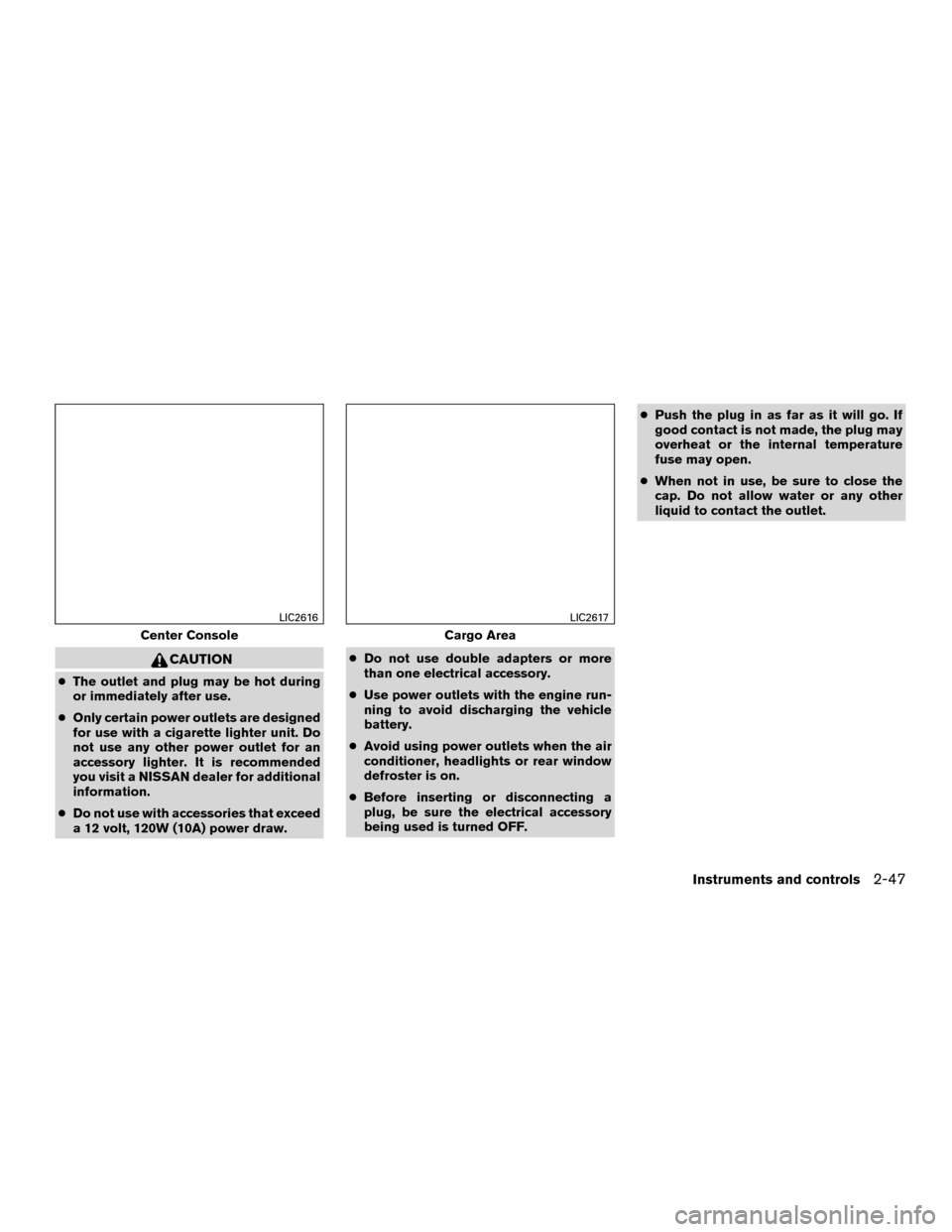
CAUTION
●The outlet and plug may be hot during
or immediately after use.
● Only certain power outlets are designed
for use with a cigarette lighter unit. Do
not use any other power outlet for an
accessory lighter. It is recommended
you visit a NISSAN dealer for additional
information.
● Do not use with accessories that exceed
a 12 volt, 120W (10A) power draw. ●
Do not use double adapters or more
than one electrical accessory.
● Use power outlets with the engine run-
ning to avoid discharging the vehicle
battery.
● Avoid using power outlets when the air
conditioner, headlights or rear window
defroster is on.
● Before inserting or disconnecting a
plug, be sure the electrical accessory
being used is turned OFF. ●
Push the plug in as far as it will go. If
good contact is not made, the plug may
overheat or the internal temperature
fuse may open.
● When not in use, be sure to close the
cap. Do not allow water or any other
liquid to contact the outlet.
Center Console
LIC2616
Cargo Area
LIC2617
Instruments and controls2-47
Page 232 of 443
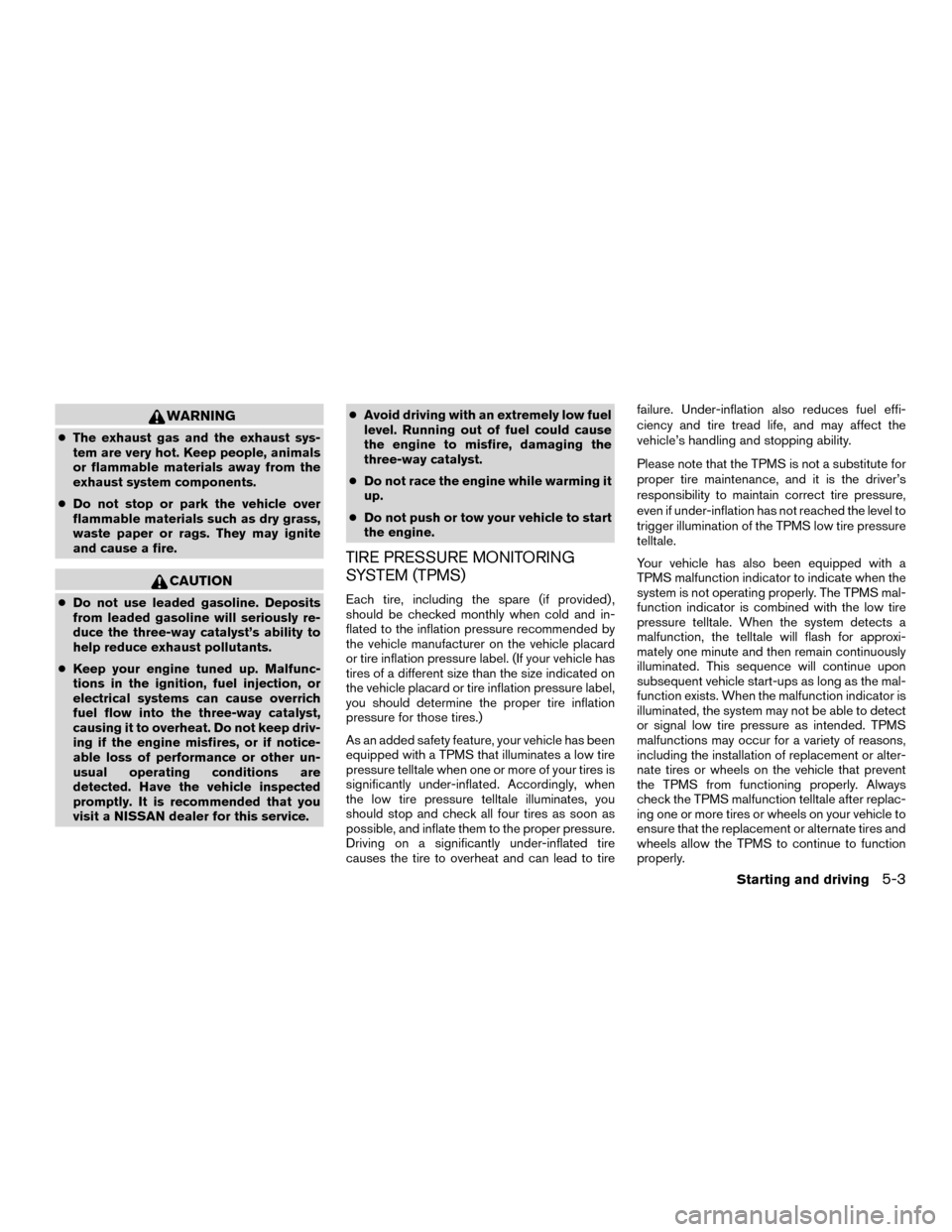
WARNING
●The exhaust gas and the exhaust sys-
tem are very hot. Keep people, animals
or flammable materials away from the
exhaust system components.
● Do not stop or park the vehicle over
flammable materials such as dry grass,
waste paper or rags. They may ignite
and cause a fire.
CAUTION
●Do not use leaded gasoline. Deposits
from leaded gasoline will seriously re-
duce the three-way catalyst’s ability to
help reduce exhaust pollutants.
● Keep your engine tuned up. Malfunc-
tions in the ignition, fuel injection, or
electrical systems can cause overrich
fuel flow into the three-way catalyst,
causing it to overheat. Do not keep driv-
ing if the engine misfires, or if notice-
able loss of performance or other un-
usual operating conditions are
detected. Have the vehicle inspected
promptly. It is recommended that you
visit a NISSAN dealer for this service. ●
Avoid driving with an extremely low fuel
level. Running out of fuel could cause
the engine to misfire, damaging the
three-way catalyst.
● Do not race the engine while warming it
up.
● Do not push or tow your vehicle to start
the engine.
TIRE PRESSURE MONITORING
SYSTEM (TPMS)
Each tire, including the spare (if provided) ,
should be checked monthly when cold and in-
flated to the inflation pressure recommended by
the vehicle manufacturer on the vehicle placard
or tire inflation pressure label. (If your vehicle has
tires of a different size than the size indicated on
the vehicle placard or tire inflation pressure label,
you should determine the proper tire inflation
pressure for those tires.)
As an added safety feature, your vehicle has been
equipped with a TPMS that illuminates a low tire
pressure telltale when one or more of your tires is
significantly under-inflated. Accordingly, when
the low tire pressure telltale illuminates, you
should stop and check all four tires as soon as
possible, and inflate them to the proper pressure.
Driving on a significantly under-inflated tire
causes the tire to overheat and can lead to tire failure. Under-inflation also reduces fuel effi-
ciency and tire tread life, and may affect the
vehicle’s handling and stopping ability.
Please note that the TPMS is not a substitute for
proper tire maintenance, and it is the driver’s
responsibility to maintain correct tire pressure,
even if under-inflation has not reached the level to
trigger illumination of the TPMS low tire pressure
telltale.
Your vehicle has also been equipped with a
TPMS malfunction indicator to indicate when the
system is not operating properly. The TPMS mal-
function indicator is combined with the low tire
pressure telltale. When the system detects a
malfunction, the telltale will flash for approxi-
mately one minute and then remain continuously
illuminated. This sequence will continue upon
subsequent vehicle start-ups as long as the mal-
function exists. When the malfunction indicator is
illuminated, the system may not be able to detect
or signal low tire pressure as intended. TPMS
malfunctions may occur for a variety of reasons,
including the installation of replacement or alter-
nate tires or wheels on the vehicle that prevent
the TPMS from functioning properly. Always
check the TPMS malfunction telltale after replac-
ing one or more tires or wheels on your vehicle to
ensure that the replacement or alternate tires and
wheels allow the TPMS to continue to function
properly.
Starting and driving5-3